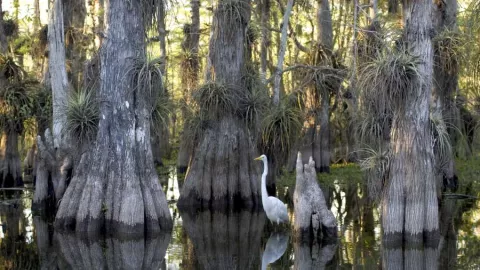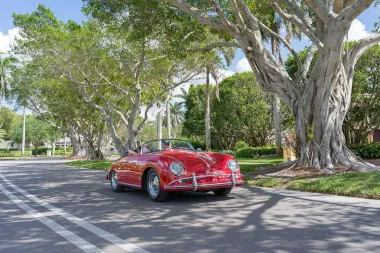The Ultimate Birding Guide To Corkscrew Swamp Sanctuary

Florida’s Paradise Coast is a popular destination in the birding community thanks to its status as both a gateway to the Great Florida Birding Trail and part of the Atlantic Flyway. With this in mind, you can witness hundreds of colorful and rare bird species, like wood storks, painted buntings and anhingas here.
In particular, Audubon’s Corkscrew Swamp Sanctuary stands out as a year-round destination for birdwatchers. From the raucous call of the wood stork to the cheerful chirpings of warblers, each visit promises new sightings and unforgettable moments. With over 200 documented species and premier birdwatching during winter migration, this hidden gem is a must-visit for both novice and seasoned birders.
In this Corkscrew birding guide, we’ll showcase the amazing feathered creatures (and other wildlife!) you can spot at the sanctuary. Plus, discover our top recommendations for budding birdwatchers to make the most of your visit.

INTRODUCTION TO CORKSCREW SWAMP SANCTUARY
As far as bird concentration and ease of viewing, Audubon’s Corkscrew Swamp Sanctuary is the best birding spot in Collier County. Plus, it’s only 40 minutes from downtown Naples. Explore the awe-inspiring beauty of the world's last old-growth bald cypress forest and the largest nesting site of the endangered wood stork.
Besides its signature wood storks, Corkscrew is also home to a dazzling array of year-round residents like the white ibis and red-bellied woodpeckers. During the winter, the sanctuary comes alive with the melodies of migrating warblers, painted buntings, summer tanagers, and a host of other colorful, songful species, making it a paradise for bird enthusiasts and nature lovers alike.
And it's not just birds—countless mammals and reptiles also call this sanctuary home, making it one of the top places for watching wildlife on Florida’s Paradise Coast. For example, spot raccoons, white-tailed deer, bobcats, treefrogs, alligators, and turtles as you stroll along the 2.25-mile boardwalk.

TIPS FOR VISITING CORKSCREW SWAMP SANCTUARY
To make the most of your birding adventure, it's important to come prepared. Start by dressing appropriately! Wear lightweight, moisture-wicking clothing in neutral colors to blend in with the environment. Additionally, make sure to silence your cell phone and keep your voice low to avoid startling the birds.
Comfortable walking shoes are essential, as you'll be traversing the sanctuary's 2.25-mile boardwalk, which winds through diverse habitats like pine flatwoods, wet prairie, bald cypress forest, and marshes. To elevate your bird-watching experience, remember to bring binoculars and a camera with a telephoto lens! If you don’t have binoculars, you can actually rent a pair at the Blair Audubon Visitor Center.
One of the best ways to ensure a successful birding trip is to participate in the Early Birding Tours. These tours start early in the morning, allowing you to observe birds during their most active period. Expert guides will help you spot and identify various species, providing invaluable insights for novice birders.
Additionally, remember to stay hydrated and protect yourself from the sun and insects by bringing water, sunblock, and bug spray. Engaging with the knowledgeable Boardwalk Naturalists, who are often available to answer questions and point out wildlife, can further enrich your visit.

OTHER PLACES TO GO BIRDING ON FLORIDA’S PARADISE COAST
Ten Thousand Islands National Wildlife Refuge: This vast refuge encompasses mangrove islands, salt marshes, and coastal waters, attracting wading birds, like egrets, black-crowned night herons, and white ibis. Birders can explore by boat or kayak to spot species such as roseate spoonbills, ospreys, and bald eagles.
Fakahatchee Strand Preserve State Park: This park is one of the southernmost locations on the Great Florida Birding and Wildlife Trail. It supports species like swallow-tailed kites, red-shoulder hawks, and barred owls.
Everglades National Park's Gulf Coast Visitor Center: Spot osprey, hawk, swallow-tailed kite, roseate spoonbill, and various herons. White pelicans arrive in the fall and stay through spring.
Tigertail Beach Park and Sand Dollar Island: Protected tidal pools attract wading and shorebirds, ospreys, gulls, and pelicans. It’s a critical nesting and resting area for least terns, black skimmers, and piping plovers.
Rookery Bay Estuarine Research Reserve: Home to bald eagles, yellow-crowned night herons, great egrets, hawks, and more. Hosts the Annual Festival of Birds in January.
Cocohatchee River: Along this wild and natural waterway, brown pelicans, ospreys, and great and snowy egrets are most visible, but you can also happen upon roseate spoonbills and bald eagles if your timing is good.
Delnor-Wiggins Pass State Park: Sanderlings, willets, sandpipers, and plovers are common on the beach. Estuary backwaters attract double-crested cormorants, anhingas, herons, hawks, and ospreys. Look for bald eagles, pileated woodpeckers, magnificent frigatebirds, and pelicans.
Naples, Marco Island and the Everglades offers an unparalleled birdwatching experience that should be on every birder's bucket list. When it comes to extraordinary birding adventures, Only Paradise will do.
Explore More of Paradise Coast

Driven by Passion: Kazuki Furusawa and the GT-R Legacy in Paradise

Driving It Forward: Tom O’Riordan on Cars on 5th and the Naples Automotive Experience

Top Scenic Drives on Florida’s Paradise Coast for Car Lovers

Inside the Naples Car Scene with Collector Pat Mullaney

Porsche Country: Porsche Collectors Lisa and John on Life in Naples
